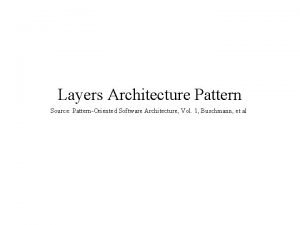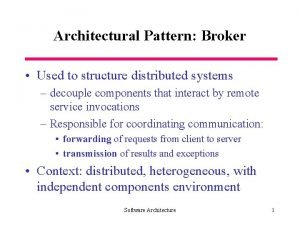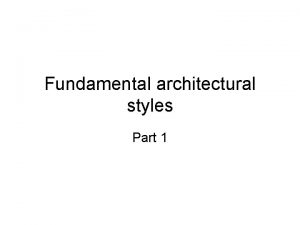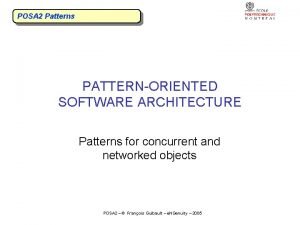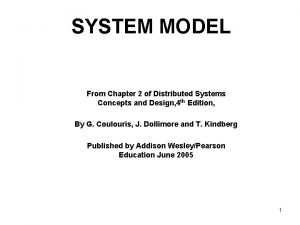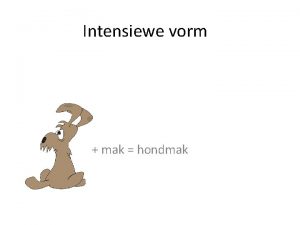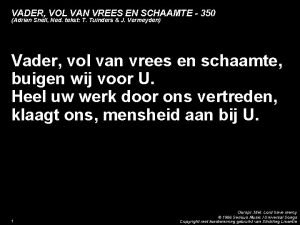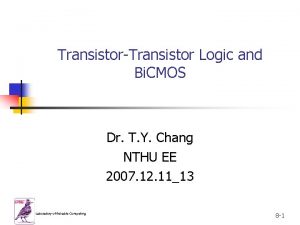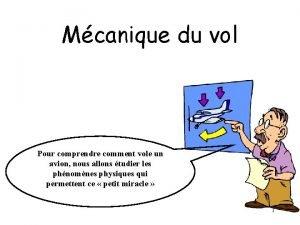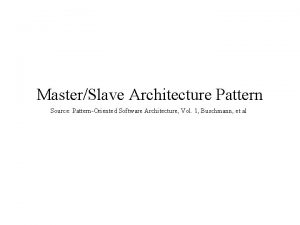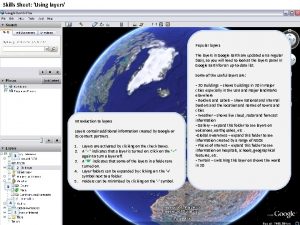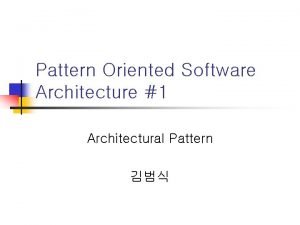Layers Architecture Pattern Source PatternOriented Software Architecture Vol


















- Slides: 18

Layers Architecture Pattern Source: Pattern-Oriented Software Architecture, Vol. 1, Buschmann, et al

Problem • You are designing a system that needs to handle a mix of low-level and high-level issues – Low-level: hardware traps, sensor input, file I/O – High-level: user interface, application logic • High-level operations rely on lower-level ones • User-visible functionality must be mapped onto the target platform • Several levels of abstraction must be spanned to perform this mapping • The system is large, and a methodical approach to organizing it is needed to keep it understandable

Solution • Structure the system into an appropriate number of layers, and place them on top of each other • Each layer represents a level of abstraction • Classes are placed in layers based on their levels of abstraction • Layer 1 is at the bottom and contains classes closest to the hardware/OS • Layer N is at the top and contains classes that interact directly with the system's clients

Solution • Layer J uses the services of Layer J-1 and provides services to Layer J+1 • Most of Layer J's services are implemented by composing Layer J-1's services in meaningful ways – Layer J raises the level of abstraction by one level

Structure • Layer J's services are used by Layer J+1 • Classes in Layer J may also use each other • There are no other direct dependencies between layers

Dynamic Behavior • Scenario I – The most common case – Request at Layer N travels down through each successive layer, finally reaching Layer 1 – The top-level request results in a tree of requests that travel down through the layers (each request at Layer J is translated into multiple requests to Layer J-1) – Results from below are combined to produce a higher-level result that is passed to the layer above

Dynamic Behavior • Scenario II – Request at Layer N travels down through successive layers until it reaches Layer J, which can satisfy the request without the help of Layer J-1 – Examples • Layer J caches previous results • Layer J pre-fetches or precomputes results

Dynamic Behavior • Scenario III – Events generated at Layer 1 travel up through successive layers, finally reaching Layer N – Examples • Interrupt generated by device driver • Asynchronous I/O operation completes • Signal received from OS – Event may stop before reaching Layer N if it can be handled by some intermediate layer – Multiple events at Layer J may be combined into a single higher-level event which is sent to Layer J+1

Implementation • Determine the number of layers (i. e. , abstraction levels) • Name the layers and assign responsibilities to them • Define the interface for each layer • Error handling strategy – Part of a layer's interface is the set of errors it might return – The errors returned by a layer should match its level of abstraction – Errors received from the layer below should be mapped into higher -level errors that are appropriate for the layer above – Low-level errors should not be allowed to "leak out" and become visible to high-level layers

Relaxed Layers • Layer J can call directly into any layer below it, not just Layer J-1 • Pros – More flexible and efficient than strict layers – Easier to build than strict layers • Cons – Less understandable and maintainable than strict layers

Known Uses: Typical layered application architecture

Known Uses: Virtual machines - Java

Known Uses: Virtual machines VMware

Known Uses: Networking protocol stacks

Consequences • Dependencies are organized in an understandable way • Individual layers can be reused, modified, or replaced – Peel off UI layer, replace with different style of UI – Modify data storage layer to use a different database – Lower layers can be reused in an entirely different application • Lower efficiency – Overhead involved in moving between layers

Consequences • Dependencies between layers can cause problems when a layer needs to be modified. – Layers above and below may be affected, and so on…. • Example Layer J – 1 class Manager { Worker m_worker; public void set. Worker(Worker w) { m_worker=w; } public void manage() { m_worker. work(); } } class Worker { public void work() { //. . working } } What if we need to change worker?

Solution: Dependency Inversion Don’t wire the lamp directly in. Make the lamp implement an interface

Solution: Dependency Inversion • Don’t depend on concrete – Depend on Abstractions Layer J – 1 interface IWorker { public void work(); } class Manager { IWorker m_worker; class Worker implements IWorker{ public void work() { //. . working } } public void set. Worker(IWorker w) { m_worker=w; } public void manage() { m_worker. work(); } } class Super. Worker implements IWorker{ public void work() { //. . working much more } }
 Layers architecture pattern
Layers architecture pattern Broker pattern in software architecture
Broker pattern in software architecture Posa1 layers pattern
Posa1 layers pattern Software posa
Software posa Software architecture definition
Software architecture definition Call and return architecture in software architecture
Call and return architecture in software architecture Interaction model in distributed system
Interaction model in distributed system Diagramme de classe agence de voyage
Diagramme de classe agence de voyage Concentration = moles/volume
Concentration = moles/volume Esx.problem.vmfs.heartbeat.timedout
Esx.problem.vmfs.heartbeat.timedout Dsr 2018 vol 3
Dsr 2018 vol 3 Vinjak sastav
Vinjak sastav Intensiewe vorm vir hoog
Intensiewe vorm vir hoog Dsr horticulture 2018
Dsr horticulture 2018 Hoeveel ml is een glas wijn
Hoeveel ml is een glas wijn Vca vol pbna
Vca vol pbna Vader vol van vrees
Vader vol van vrees Vol and voh
Vol and voh Vol plané
Vol plané
